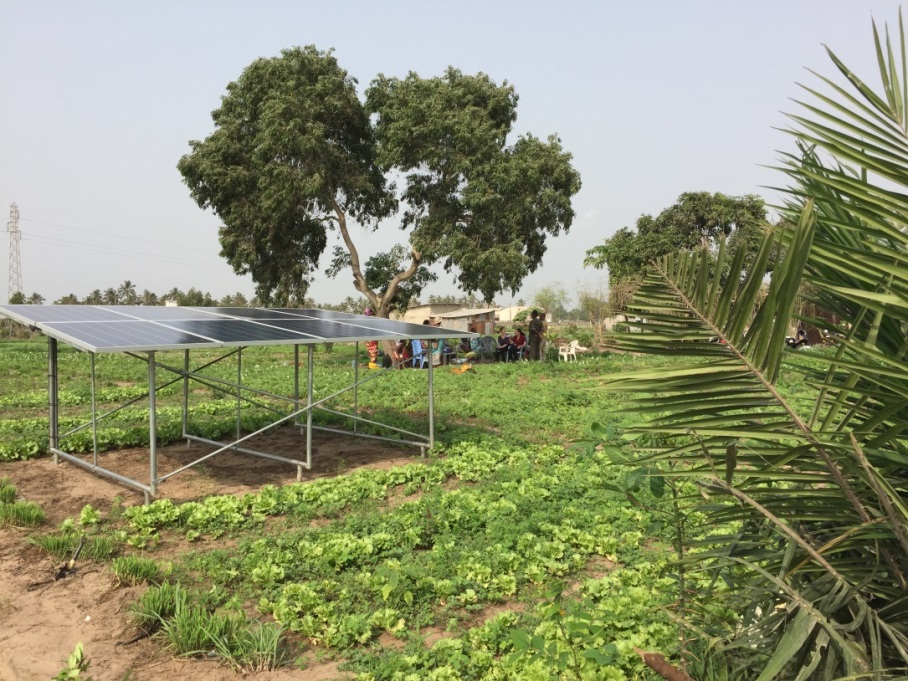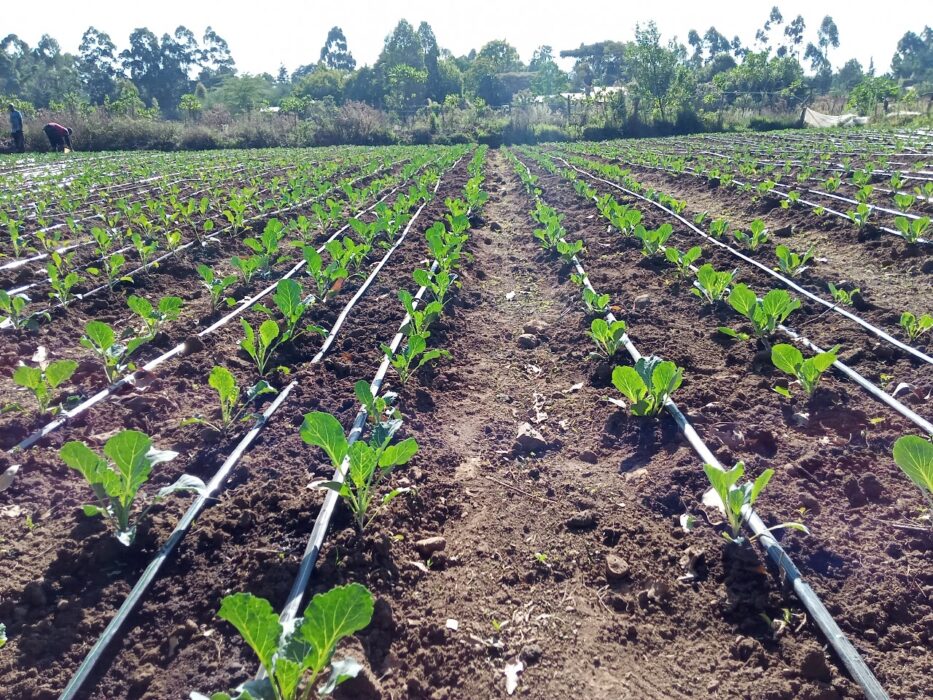
Drip Irrigation System Layout
Grekkon Limited’s drip irrigation system layout is done for all farm sizes, and all crops. There 3 ways in which the company gathers data to develop a drip irrigation system layout
- Farmers provide detailed sketches as directed by the company from which a drip irrigation system layout is developed. This sketch will include; the farm dimensions in meters, the water source type, distance to the water source from the farm, details of any existing irrigation infrastructure, any existing roads or pathsways, any none farmable sections (rocky areas, wet lands, built up locations etc), planting beds layout, the direction(s) of slope, and the total vertical elevation
- Provide the farm’s map coordinates from which the company assesses the farm layout using satellite technology
- Conduct a physcal site assessment visit. This is only carried when 2 above cannot be done
The company only charges for the 3rd service to cover the logistical costs


A sample drip irrigation system layout for a 40 acre farm by Grekkon Limited
The company’s irrigation engineers will conduct a physical visit on a prospective farm to determine the following
i. The water source. The company measures the water volume, and analysis the quality. The volume determines the irrigation system to use, the size of the water pump, and the acreage covered. For intance, a farmer with a borehole yielding 15 cubic litres per hour is best positioned to irrigate using drip irrigation. His irrigated acreage will not exceed 30 acres for optimal water utilisation. On the other hand, a farmer by a large permanent river or lake water source will irrigate hundreds of acres using any irrigation method preferred. The water quality determines the type of filtration system to install.
A screen filter is for water under low pressure with a negligible amout of suspended dirt or other particles. A disc filter is preferred for water under high pressure, with a negligible to a modest amount of suspended dirt orcother particles. A sand filter is for dirty water under high pressure

A simple drip irrigation kit by gravitational flow system layout
ii. The dimensions of the farm in meters. to provide the total acreage. The acreage will determine the pipe diameter sizes, the water pump’s flow rate, and the sub-division of the irrigation blocks
iii. Slope. The elevation of the farm gives the vertical head or lift needed. This is important in determining the pressure rating of the water pump to install, the pipe diameters, the planting beds layout (these should be done against the slope), and the size of the irrigation blocks
iv. Any existing irrigation infrastructure; to determine what can be used or incorporated into the new system
v. Provide advise on security measures for key company installations such as; large water pumps, solar modules, solar inverters, control panels, cables, and other high value accessories
Key Requirements To Install A Drip Irrigation System
1. A water source
2. A water pump and piping mechanism to move this water from the source to the tank or directly to the drip irrigation system.
3. Water storage tank if you’re using gravity to irrigate
4. A tank connector
5. Pipes for the mainline and sub-main line.
6. Mainline and sub mainline fittings
7. Drip irrigation water filter
8. Drip irrigation pipes
9. Accessories
10. Ball valves
Steps To Follow In Designing A Drip Irrigation Layout
- Determine where the water pump or water tank will be placed. Water tanks are used for small acreage gravity flow irrigation, and should be placed at highest elevation to allow ease of water flow by gravity
- The main line originates from the water tank or water pump. The size of the main line determines the volume of irrigation water delivered to the farm in every irrigation session. The larger the farm, the greater the diameter of the mainline
- The water filter is connected along the main line
- A venturi fertigation system where needed is along the main line. The venturi fertigation system is a chemifertigation centre that allows drenching of chemicals and fertiliser through the drip irrigation system
- The air release valves are along the main line. Air release valves are installed where the water pressure is high. This is in steep elevations, or if the water is chanelled via a high pressure water pump. They prevent air locks in the irrigation system. Air locks dramatically reduce, or cease water flow in the system
- A sub main line will be connected to the main line along its way using hydrants. Hydrants are points from which irrigation in a block is controlled from. They can be automated using solenoid valves, or manually operated through ordinary valves. The decision to have sub main lines is a factor of the farm size. In small drip irrigation set ups, the drip pips are directly connected to the main line. In larger acreage, the drip line originate from the sub mainline
- The main line is always larger in diameter than the sub main line. The diameter of the sub main line is determined by the size of the main line. The larger the latter, the larger the sub main line is
- The hydrants are positioned at the beginning or end of every irrigation block
- Planting beds are done against the slope. This is to slow down erosion, and allow better water percolation in the soil during the rainy season. The width of the planting bed is determined by the crop type
- Drip lines lie along the length of the planting beds. The number of drip lines per bed depends on the crop type. E.g 2 drip lines are installed for tomato, 3 drip lines for onion or garlic, and 4 drip lines for some herbs and spices

A 3 row drip layout per bed installed in Birikani area of Kajiado county
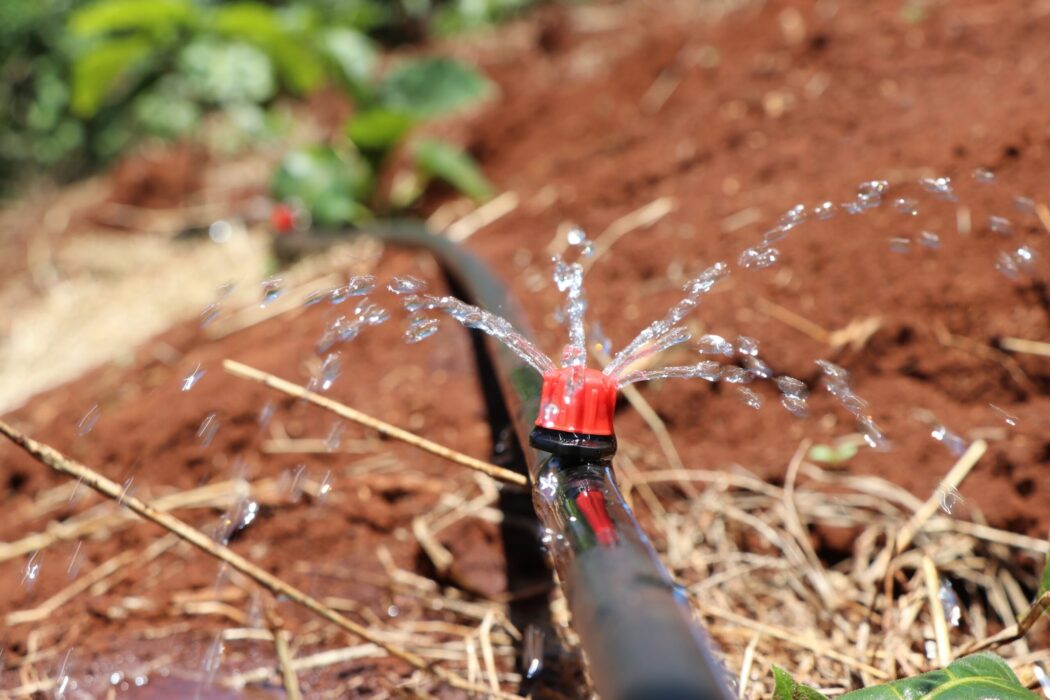
Adjustable Button Drippers For Irrigation
1. What is a button drip emitter?
Adjustable button drippers for irrigation are irrigation accessories attached onto a high density polyethylene (HDPE) pipe.
They deliver a consistent and uniform amount of water the crop by regulating the flow. Button drippers in Kenya, button drip are common in fruit trees, forestry and hedges irrigation
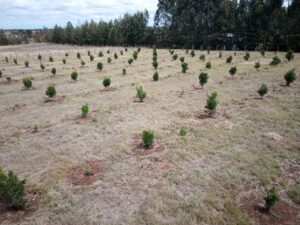
A macadamia crop under button drip irrigation installed by Grekkon Limited in Iten area, Elgeyo Marakwet county. January 2021
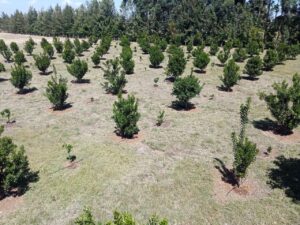
Same macadamia crop in January, 2023
2. How do you install button drippers?
A perforation is made on the HDPE pipe with a drip punch, then the button dripper’s pointed end is pushed into this hole. This punching is done at the point where the tree crop is. But it will be away from the trunk to ensure that water flows to the roots below. The button dripper will be 3-6 inches away from the trunk. This will also prevent fungal infections and other types of diseases.
For younger tree crops, a single button dripper or emitter is sufficient. However, with older larger trees, 2 or more button drippers are provided according to the plant’s water need. In this case, have them equally on the opposite sides of the tree crop to promote even root growth. Two or multiple button drippers ensure that if one is blocked, the other one or the rest continue to water
3. How do you use an adjustable button dripper?
Once in place on the irrigation line, you will adjust your button dripper from 0 discharge to 70 liters per hour flow of water. This is done by turning the dripper to achieve different flow rates as per the crop water needs
4. How long should button drippers run?
Your adjustable button drippers for irrigation will run for 30 minutes to an hour. This is guided by the moisture requirement of the soil, as per the prevailing weather conditions
5. How many button drippers can I run on one line?
This is determined by the diameter size of the irrigation pipe. The larger it is, the more water it ferries over a longer distance. Therefore, the greater the number of button drippers. The other factor is the flow rate of the adjustable button drippers themselves. If adjusted to maximum flow rate (70L per hour), then the line will have less. If the adjustment is to half of that flow rate, then a similar line will carry twice as much
6. How do I increase the pressure in my button drip irrigation system?
They are several ways to raise the irrigation water pressure in your button drip irrigation system
i. Divide the farm into blocks, each of which is irrigated separately. This way, irrigation water is channeled to particular block under high pressure
ii. If it is by gravity flow, then by raising the storage elevation. This will work where raised water tanks are the source of irrigation water
iii. By introducing an external source of pressure, such a s water pump to boost the flow of irrigation water in the system
Adjustable button drippers for irrigation price in Kenya
The cost of a button dripper is Kes 12 a unit
The cost of a button dripper irrigation system per acre depends on the tree crop spacing. In the tabulation below, we provide 3 examples
| Avocado | Passion / Paw Paw | Apple / Tree Tomato | ||
| Spacing | 5M x 5M | 3M x 3M | 2.5M x 2.5M | |
| Cost per Acre | Kes 85,000 | Kes 100,000 | Kes 115,00 | |
Solar Irrigation Kits In Kenya
Grekkon Limited’s solar irrigation kits in Kenya utilise soalr energy as the primary power source to pump water, and distribute it in the farm. Our solar irrigation kits are a clean energy technology that reduces greenhouse emissions. They substitute fossil fuels as an energy source. The company supplies and installs these kits within the east Africa region mainly for smallholder farmers
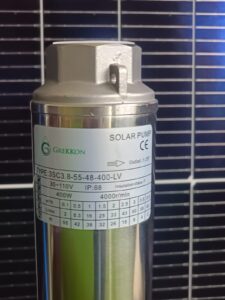
A Grekkon solar submersible water pump for smallholder farmers
Solar Irrigation Kits In Kenya
Components
- A water source. This will be a deep or shallow well, a dug out or natural water reservoir, a river, lake or a an artificial water storage unit
- Mounting structure for solar photovoltaic (PV) panels
- A solar pump. This will be either a submersible solar electric water pump (ideal for wells), or a surface solar water pump. The pump will be fixed or portable depending on the size
- A solar water pump controller
- The irrigation system. Most solar powered irrigation systems have the drip irrigation kit as the watering component. This is because it operates under low volume, low pressure. However, some farmers opt also for the rain hose irrigation kit depending on the crop type, available water volume, and the pumping pressure. The rain hose kit works best at high water volume, under high pressure
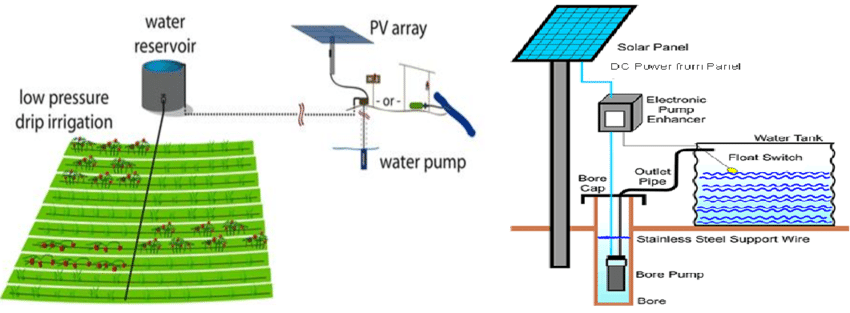
Components of a solar irrigation kit
Solar Irrigation Kits In Kenya
How they work
- Electricity to run the solar water pump is generated by solar PV panels. They absorb the sun’s energy converting it to direct current (DC) electical energy
- This DC energy flows into an inverter/ controller which converts it to alternating current (AC) electrical energy
- The AC power is channeled to the motor, which runs the pump
- The pump distributes water to the irrigation system
The number of panels used depends on the motor size. The larger it is, the higher the number of PV panels required
A farmer will opt to irrigate by pumping directly to the irrigation system, or to an elevated storage unit, from which the water flows to the irrigation system by gravity
Solar Irrigation Kits In Kenya
Benefits
i. It allows for water pumping in electricity off-grid locations by generating its own solar electric power
ii. It reduces the emissions of greenhouse gases as it does not run on fossil fuels
iii. Farmers produce all your round so long as irrigation water is available
iv. It has near zero maintainance and operating costs, as there’s no drudgery during irrigation
v. There are no opertional costs unlike fossil fuel powered water pumps that require diesel or petrol purchases to run
Solar Irrigation Kit Price In Kenya
Drip Irrigation Kit
| Acreage | Price (Kes) |
| 0.25 | 105,000 |
| 0.5 | 145,000 |
| 1 | 230,000 |
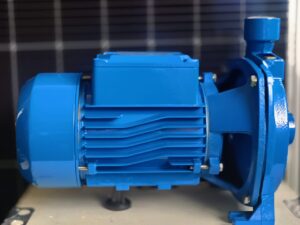
A Grekkon surface solar water pump for irrigation
2. Rain hose kit
| Acreage | Price (Kes) |
| 0.25 | 85,000 |
| 0.5 | 110,000 |
| 1 | 145,000 |
Solar Irrigation Kits In Kenya
FAQs
1. What is a solar power irrigation system?
It is a unit composed of a solar pump, and an irrigation kit
2. Do solar panels work at night?
No they don’t. However, a farmer can choose to set up a battery to store power during the day, to power the irrigation system at night
3. Do solar panels work in the rain?
They work optimally under clear skies. Their efficiency is dramatically reduced with heavy cloud cover
4. How many solar panels does it take to run a water pump?
It depnds on the size of the motor attached to the solar pump. The greater it is, the higher the number of solar panels required
5. What is the weakness of a solar pump?
They do not work if there is no solar energy provision
6. What solar pump is best for agriculture?
Grekkon limited has the best solar powered water pumps for agriculture because they are designed for small, and medium holder farmers in Africa who constitute about 87% of the farmeing community on the continent
7. How long do solar water pumps last?
For more than 20 years with regular servicing
8. Does a solar water pump need a battery?
No. It will work with the current received directly from the solar panels
9. How deep can a solar pump work?
It depends on the head of the submersible solar pump. Some work in wells as deep as 500M
10. Do you need an inverter with solar panels?
Yes if the pump uses AC current. The inverter will convert the DC to AC. However, a DC pump will not require an inverter
Fossil fuel powered water pumps carbon emissions calculation
The downside of fossil fuel powered water pumps is CO2 emissions, which contribute to global warming, the chief reason for negative climate change being experienced today. To calculate the quantity of CO2 emission from a diesel water pump, multiply the fuel usage in litres by a factor of 2.67. For example; a pump that consumes 100 litres of diesel per month emits 267kgs of CO2 emissions monthly. To calculate the quantity of CO2 emission from a petrol water pump, multiply the fuel usage in litres by a factor of 2.3035. For example; a pump that consumes 100 litres of petrol per month emits 230.35 kgs of CO2 emissions monthly.
How To Install Rain Hose Kits
Grekkon Limited’s manual on how to install rain hose kits in Kenya is an easy to read step by step guide. It details every aspect of rain pipe assembly in the farm to provide understanding to farmers. As the pioneer of rain hose kits in Kenya, we are keen to that farmers receive the full benefit of rain pipe irrigation
What is the price of a rain hose irrigation kit?
| Diameter size | Flow rate per 100M | Price in KES |
| 32mm or 1″ | 13 cubic litres per hour | KES 2,500 |
| 40mm or 1-1/4” | 16 cubic litres per hour | KES 5,800 |
| 50mm to 1-1/2″ | 22 cubic litres per hour | KES 6,800 |
Rain hose pipes work under high gravity pressure (from 6M or 0.6bar), and with high volume water pumps. The discharge rate of the water pump is from 40 cubic litres per hour. These water pumps are surface solar, electric, petrol or diesel powered
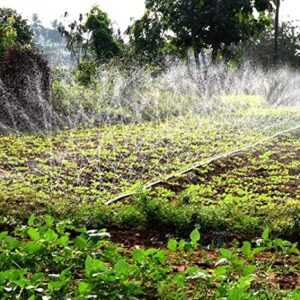
A well connected rain hose pipe
How To Install Rain Hose Kits
- Trench where the poly vinyl chloride (PVC) main line will be laid. This is not necessary for the high density polyethylene (HDPE) which are surface pipes. PVC pipes are sub-surface pipes because they have no UV-treatment, and will thus degrade easily under the sun. HDPE pipes have UV treatment and will be surface pipes
- Connect the PVC or (HDPE) main line to the water pump or high tank. This pipe evacuates water from the source to the farm and is the largest in diameter. The larger the pipe diameter, the more the water it delivers. .
- Join the HDPE or PVC sub-main line to the main line. The sub-main line is smaller in diameter, and so carries less water. It is joined to the main line through PVC or HDPE accessories such as; tees, elbows, saddle clamps, adaptors or valve sockets
- Connect the rain pipe to the sub-main line or the main line where a sub-main line does not exist. This is done with a rain hose connector or a saddle clamp
- Spread the rain hose along the length, and close the terminal end with an end cap
- Connect one rain pipe to another with a connector
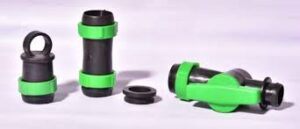
Rain hose fittings from left to right: end cap, connector, rubber, and ball valve
A drilling tool is the only tool used when installing a rain hose kit. This is to create an opening on the main or sub-main line to insert the rain pipe ball valve
How to Install Rain Hose Kits
Components of a rain hose irrigation kit?
1. End-caps. They close the end of the pipe to prevent further water flow
2. Starter off-takes. They connect the rain pipe to the PVC or HDPE main line that supplies water to the rain hose from a water pump or highly elevated water tank
3. Pipe connectors. To connect one rain hose pipe to another
4. Mini valves. To control water flow to the rain hose pipe
The diameter of the pipe are; 25mm, 32mm, 40mm and 50mm. A grower chooses the preferred size based on crop water needs and area of irrigation. For instance, a farmer with 1 acre of the crop will comfortably water with the volume delivered through a 32mm rain hose pipe.
Another grower with 5 acres will better irrigate with a 50mm rain hose pipe. An acre of crop uses 1,000 meters of 25mm, 800 meters of 32mm rain hose pipes, 600M of 40mm pipes, and 400M of 50mm pipes
How To Install rain Hose Kits
Rain hose irrigation system requirements
- The system requires a pressure head of 30M, and above
- When using a water pump to power the rain hose irrigation kit, the discharge rate should be from 45 cubic litres per hour
- The rate of water discharge is determined by the diameter size, and number of pores on the rain pipe. For instance, a rain pipe with 5 holes per cluster discharges less water than the one with 7 holes in a cluster
- It irrigates in opposite directions at a radius of 3M for the 32mm pipe, 5M for the 40mm pipe, and 7M for the 50mm pipe
- The vertical height of this water jet is 1M
Rain Hose Versus Drip Irrigation
- Rain pipes irrigate in an overhead fashion, drip lines irrigate to the root zone
- Drip tapes are water efficient, rain hose kits require large water volume
- Rain pipes have a higher pressure requirement than drip pipes
- Drip lines have emitters, while rain hose kits have pores done with nano technology
- The discharge rate for drip lines is 1.2 to 4 litres per hour per emitter, while the rain hose pore’s is from 7 litres per hour per emitter
- The cost of a drip kit installation per acre is from Kes 100,000, while the rain hose is from Kes 75,000
- The rain hose pipe’s minimum diameter is 25mm/ 3/4″, while drip tape’s is 8mm
Advantages Of A Rain Hose
- water saving and cost effective
- It is easy to install, use and maintain
- Ran hose nanotechnology punched holes are less prone to clogging
- It is used in a broad range of crops
- Rain hose pipes are light and easy to move about
- It irrigates uniformly
- It works under both low gravity and high water pump pressure
Rain hose irrigation system is for the following areas and on these crops
- Crop nurseries; vegetables, fruit trees, forestry
- Short vegetable crops (knee-high and below); cabbage, lettuce, broccoli, kales, spinach, collards, broad beans, carrot, strawberry, and others
- Pasture; grass and legumes
When choosing the crop to irrigate using this method, consider its susceptibility to foliage fungal infections predisposed by leaf surface wetness. Tomato, potato, peppers, peas, green beans, and chili easily succumb to foliage fungal infections when overhead or a rain hose system is used for a long time
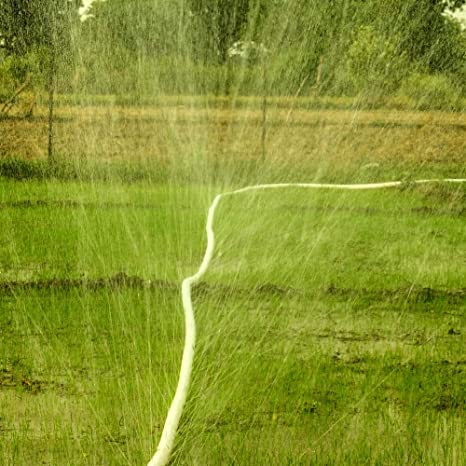
Pasture irrigation with a rain hose
How To Install Rain hose Kits
FAQs
a. What is the difference between a rain hose irrigation system and a sprinkler system?
- The technology. The rain pipe irrigation system is designed using nano technology
- The mode of spray. A sprinkler sprays its water in one direction, a rain hose pipe sprays in 3 directions (vertically, horizontally, and diagonally)
- Placement. A sprinkler is placed upright on the surface or sub-surface (for pop up sprinklers). A rain hose is laid on the ground
b. What is the pressure in a rain pipe?
The minimum operating pressure is 30M head / 3 bars
c. What is the spacing for rain hose irrigation?
The distance from one rain pipe to another is from 1.5M depending on the operating pressure, and pipe diameter
Grekkon limited is the largest supplier and installer of rain hose irrigation systems in Kenya, and in the east and central Africa region
Irrigation Company In Nairobi
In 2017 through 2018, Grekkon Limited was an irrigation company in Nairobi servicing small to medium scale holders. The company’s focus was on irrigation and allied services. these are;
- Irrigation. drip, overhead, and sub surface irrigation systems
- Dam liners. for irrigation water harvesting and conservation
- Greenhouses. steaal and wooden types
- Borehole drilling
- Water pumps. solar, electric, petrol and diesel types
- Solar dryers. for post harvest crop loss management
- Agricultural nets. bird nets for bird pests, shade nets for , and insect nets for insect pests
- Trays. seedling trays for seedling propagation, and hydroponic trays for hydroponic fodder production
- Coco peat. a non soil media for use in seedling trays
- Mulch paper. to manage field water loss through evaporation, weed and pest control
While improving the clients’ overall yield, and income from farming. The company focuses on this smallholder, and medium holder niche because of the presence of large irrigation service providers in the country. These companies clientele are the large ornamental, cereal and vegetable growers. Smaller growers had to fend for themselves because they were never a priority for these large corporates. A hallmark of the company is the free 4 month agronomy training programs for all their farmers. Grekkon Limited is the only company that offers this free service to farmers in Kenya
The company organizes ‘training days’ in various regions of the country. Growers come to learn of new and existing technologies.
The other objective was to do further by offering expert irrigation, greenhouse, water pumps, and dam lining expertise to these small scale to medium scale commercial farmers, who had no professional entity to consult for such. This was through physical site visits to carry out assessments, provide advice, and carry out irrigation project reviews afterwards. And so, Grekkon Limited – Irrigation Hub was born. It is headquartered in Athi River, with outlets in other key agricultural zones in Kenya
Two years after establishment, Grekkon won the coveted Most Preferred Irrigation Systems Company of the Year award in 2019. This was at the prestigious Agribusiness Excellence Awards ceremony. The farmers in their votes had finally spoken!
Irrigation Company In Nairobi
1. Irrigation Products
- Drip kits. For both vegetable and fruit tree/ forestry irrigation. This includes; drip tape, 16mm HDPE pipe, starter connectors, off-takes, drip to drip connectors, button or online drippers, and end caps
- Rain hose kits. It has; rain hose pipe, off-takes, connectors, and an end cap. Rain hose kits are best utilised where drip irrigation systems cannot be installed such as is pasture, or crop nurseries
- Sprinkler systems. There are various types;
3.1. Pop up sprinklers. These are sub-surface sprinklers for lawns, golf course, football pitches, and gardens
3.2. Rain gun sprinklers. These are metallic high pressure, high volume sprinklers for use in all crops. They are well utilised in larger acreage because they have a wide area of spray
3.3. Impact sprinklers. They are plastic and range from 1/2″ to 1″. Mostly used to irrigate small vegetable farmes, or pasture
3.4. Meganet sprinklers. These are plastic sprinklers that range from 1/2” to 1”. They are a suitable alternative to impact sprinklers
3.5. Butterfly type sprinklers. They are for lawns and small gardens like the kitchen garden
3.5. Micro sprinklers. They irrigate individual fruit tree plants, just like button drippers. However they cover a wider area, and provide better humidity around the crop’s root zone
In this video below, a smallholder farmer who was an early adapter of Grekkon’s rain hose kits. She speaks about her growing experience
4. Misters and foggers. Used in greenhouses for seedlings watering, and humidity control
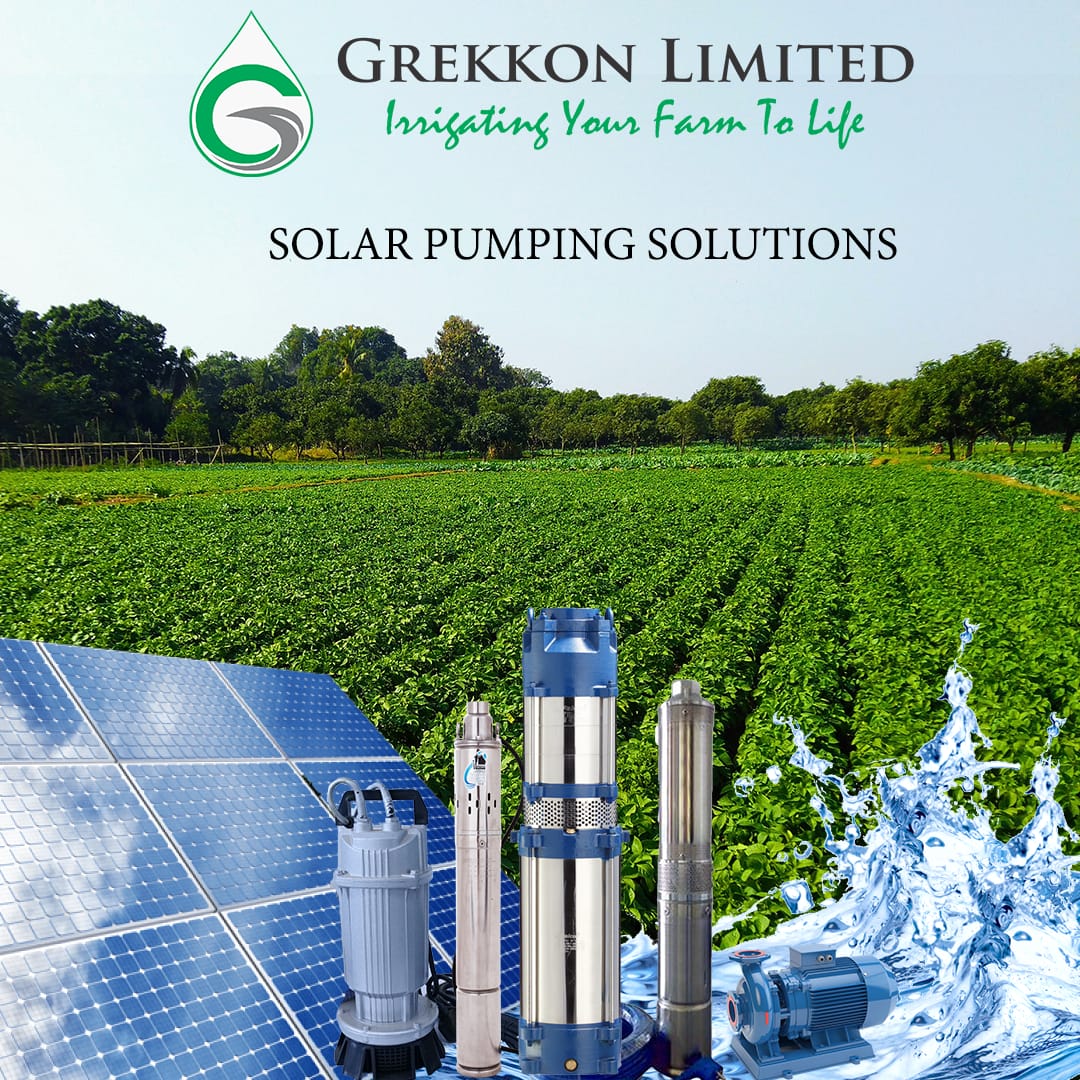
Solar water pumps by Grekkon Limited
5. Water pumps;
As an irrigation equipment supplier, every irrigation system is backed by the following types of water pumps to draw water from a source, to supply the irrigation system
i. Solar water pumps. These are either surface or submersible types. Submersible water pumps work under water, while surface water pumps are ground based
ii. Electric water pumps. Like solar water pumps, they’re surface and submersible options
iii. Diesel generator water pumps. They run on diesel powered engines. They are portable or fixed types. The latter are larger in size
iv. Petrol water pumps. They run on petrol powered engines, and are smaller than diesel water pumps
6. Irrigation pipes
6.1. HDPE pipes from 16mm through 280mm diameter. The pipe thickness is from PN6 through PN25
6.2. PV pipes from 20mm through 280mm diameter. The pipe thickness is from PN6 through PN25
6.3. Suction pipes for supply with water pumps
6.4. Delivery pipes as either canvass or PVC material
Irrigation Company In Nairobi
Water pump accessories
Accessories that accompany motor powered pumps are; foot valves, clips, suction pipes, adaptors, splicing kits, control boxes, invertors (for DC to AC converstion) cables, cable ties, solar panels (for solar pumps), and a solar panel support structure
Accessories that accompany motor powered pumps are; foot valves, clips, suction pipes, and adaptors
Every irrigation system has a main, and/ or sub-main pipes. We advice on the right pipe thickness, size and type based on
- Land size; determines pipe size. Large pipes for large acreage. Our pipe sizes range from 16mm to 180mm in diameter
- Irrigation system adopted; any of the 1 to 3 above
- Land ownership system; leased or owned? HDPE for the former, PVC for the latter
These pipes have specific fittings which are; elbows, tees, valve sockets, ball valves, couplings, adaptors,sockets,saddle clamps, and end caps by type and size
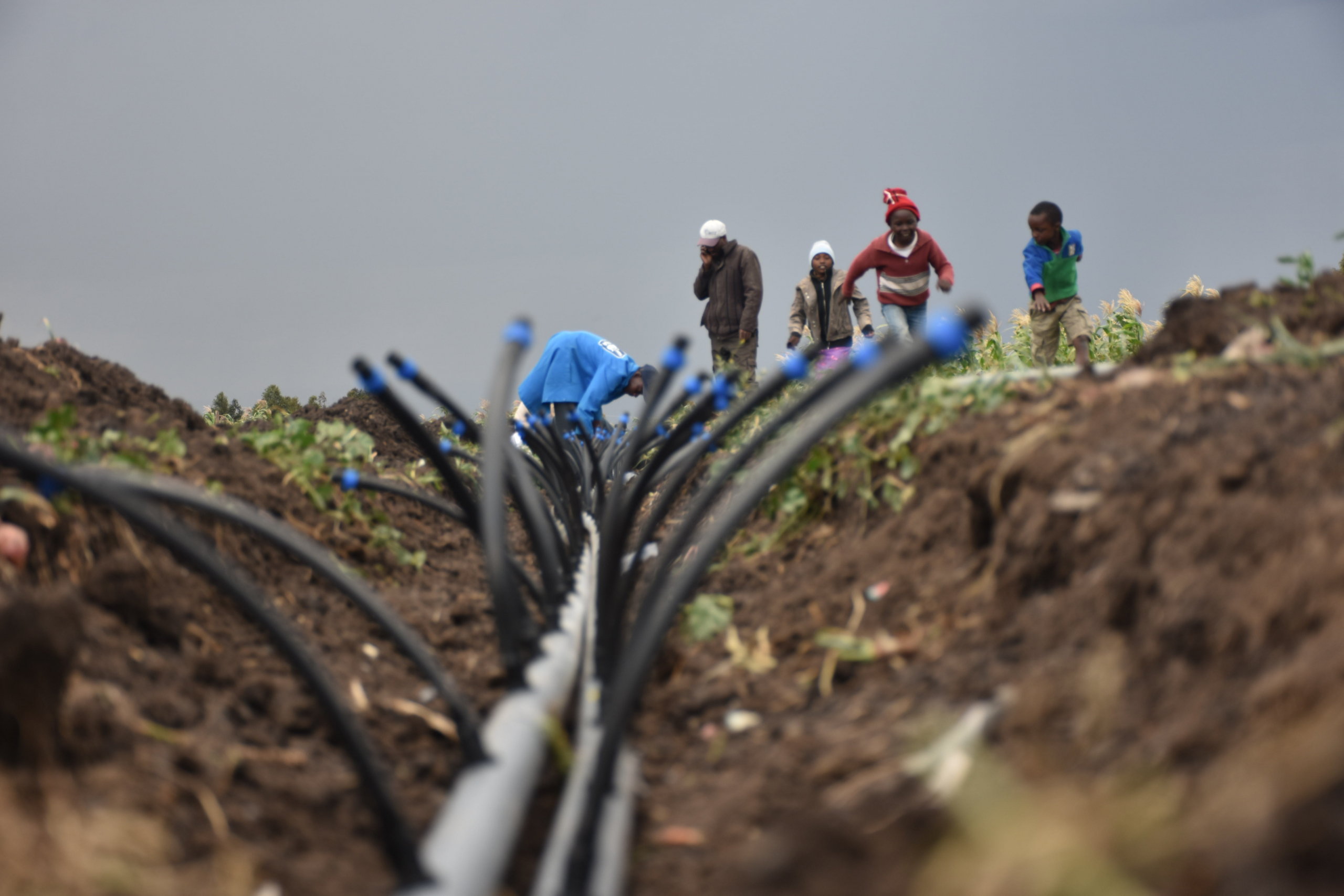
Drip irrigation system under installation by Grekkon Limited using PVC pipes as main and sub-main lines
Irrigation Company In Nairobi
Installation Service
Our irrigation service team conducts systems installations service in east Africa. We offer advisory services to manage the system well for many years
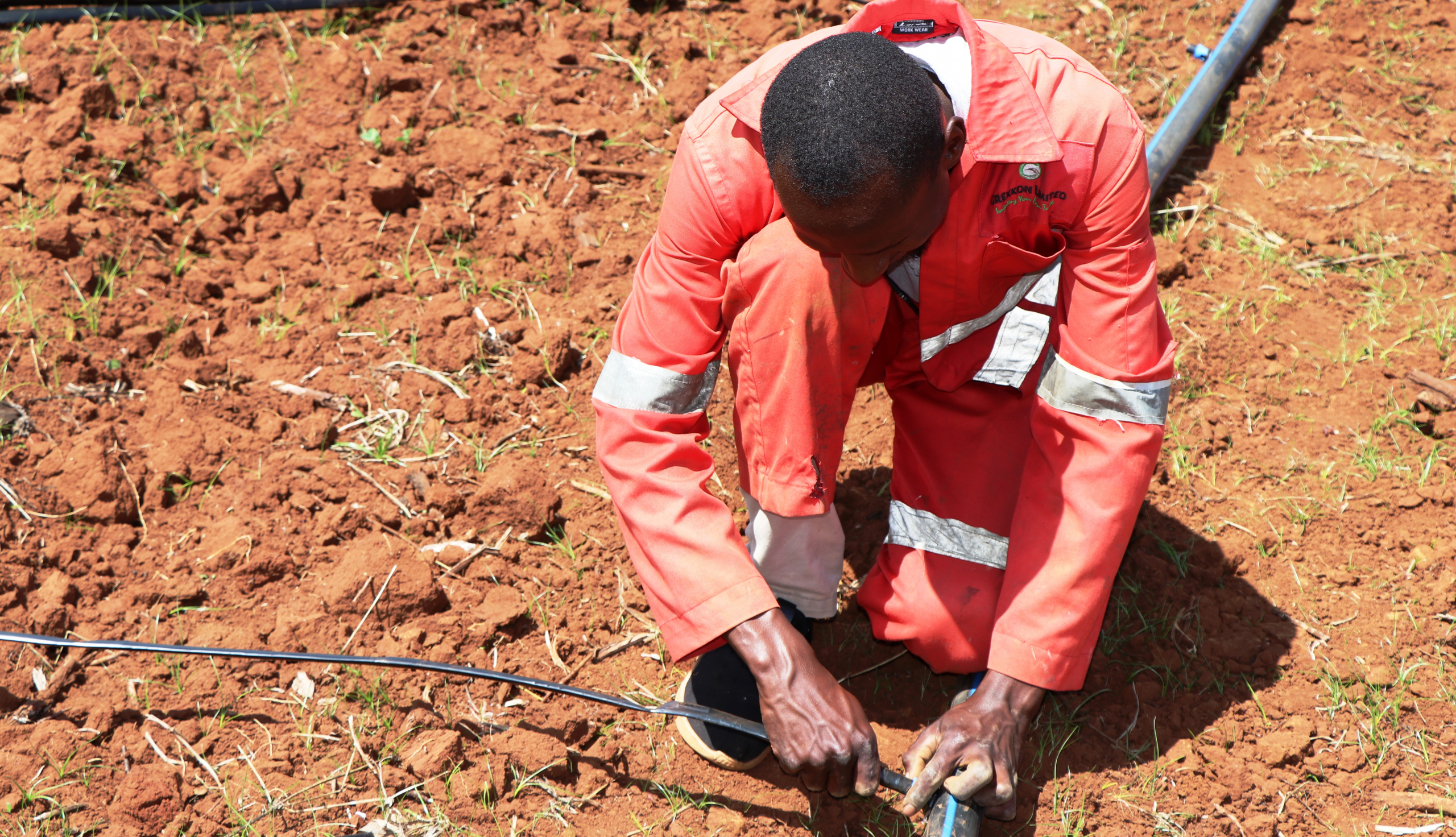
A client’s irrigation system installation by a company technician
Irrigation Company In Nairobi
Key Attributes
Innovation
Grekkon Limited in its innovation introduced the rain hose irrigation system. This new product solved many irrigation challenges for commercial vegetable and corn farmers. The company is the market leader in research and commercialization of natural solar dryers, each unit designed to meet the product or market drying requirements
Today, Grekkon Limited is the largest supplier of natural solar dryers within the east Africa community states
In 2024, Grekkon Limited introduced the first color coded drip tapes in the Kenyan market
Team
Grekkon Limited’s resounding success is largely due to its team of field professionals who provide engineering, commercial, and technical services
Country Wide Presence
As an major irrigation company in Kenya, Grekkon Limited has offices in; Athi River, Nairobi, Kisumu, Eldoret, Nyeri, and Nyahururu
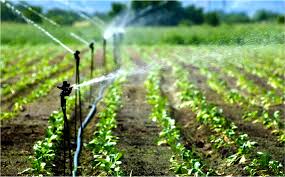
Types of Irrigation Pipes In Kenya
Grekkon Limited supplies and installs various types of irrigation pipes in Kenya. These pipes are of different diameter sizes, lengths, and wall thickness. The larger the pipe diameter, the more volume of water it carries, and the lesser the frictional losses. With a longer pipe, a grower requires less connections between pipes. Wall thickness determines the amount of water pressure a pipe will withstand. The thicker the wall, the greater the water pressure withstood. It is indicated as pressure nominal (PN), with a number. The higher the number the thicker the walls
Types of Irrigation Pipes in Kenya
1. HDPE pipes (High density polyethylene pipes)
They are black in colour and are manufactured as rolls of 100M for these diameter sizes below
16mm, 20mm, 25mm, 32mm, 40mm, 50mm, 63mm, and 90mm.
Larger then 90mm, we supply them as 50M rolls. Grekkon Limited’s HDPE pipes are UV treated for surface application. They have a long lifespan because they are not easily degraded by the sun when exposed.
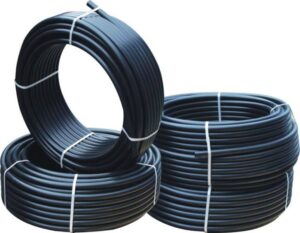
16mm HDPE pipes
HDPE Pipe prices in Kenya
| Size in MM | PN6 | PN8 | PN10 | PN12.5 | PN16 | PN20 | PN25 | Length (M) |
| 16 | 17.00 | 17.00 | 100M | |||||
| 20 | 25 | 28 | 31 | 33 | 36 | 41 | 49 | 100M |
| 25 | 34 | 36 | 40 | 46 | 52 | 64 | 74 | 100M |
| 32 | 49 | 49 | 59 | 71 | 86 | 101 | 120 | 100M |
| 40 | 61 | 76 | 90 | 112 | 132 | 157 | 187 | 100M |
| 50 | 95 | 115 | 139 | 169 | 206 | 243 | 289 | 100M |
| 63 | 151 | 178 | 222 | 269 | 324 | 390 | 454 | 100M |
| 75 | 207 | 255 | 313 | 382 | 453 | 547 | 648 | 100M |
| 90 | 300 | 364 | 450 | 547 | 657 | 789 | 930 | 100M |
| 110 | 441 | 548 | 669 | 810 | 974 | 1,170 | 1,394 | 50M |
| 125 | 568 | 700 | 854 | 1,044 | 1,264 | 1,514 | 1,793 | 50M |
| 140 | 716 | 876 | 1,073 | 1,307 | 1,575 | 1,898 | 2,254 | 50M |
| 160 | 940 | 1,149 | 1,399 | 1,706 | 2,063 | 2,472 | 2,932 | 12M |
| 180 | 1,171 | 1,444 | 1,770 | 2,165 | 2,614 | 3,126 | 3,706 | 12M |
| 200 | 1,451 | 1,789 | 2,183 | 2,655 | 3,223 | 3,866 | 4,584 | 12M |
| 225 | 1,824 | 2,168 | 2,771 | 3,372 | 4,080 | 4,895 | 5,797 | 12M |
| 250 | 2,254 | 2,767 | 3,395 | 4,153 | 5,017 | 6,015 | 7,154 | 12M |
| 280 | 2,819 | 3,492 | 4,265 | 5,205 | 6,291 | 7,560 | 8,972 | 12M |
| 315 | 3,592 | 4,389 | 5,401 | 6,596 | 7,963 | 9,562 | 11,358 | 12M |
| 355 | 4,538 | 5,573 | 6,875 | 8,363 | 10,108 | 12,147 | 14,401 | 12M |
| 400 | 5,755 | 7,106 | 8,688 | 10,605 | 12,833 | 15,408 | 18,288 | 12M |
| 450 | 7,277 | 8,987 | 11,007 | 13,433 | 16,251 | 19,507 | 23,137 | 12M |
| 500 | 8,976 | 11,087 | 13,601 | 16,576 | 20,052 | 24,038 | – | 12M |
| 560 | 11,252 | 13,877 | 17,038 | 20,796 | 25,120 | 30,158 | – | 12M |
| 630 | 14,257 | 17,529 | 21,579 | 26,285 | 31,828 | 38,163 | – | 12M |
2. PVC Pipes (Polyvinyl chloride pipes)
PVC pipes are 6M long, come in different diameter and wall thickness sizes. They have no UV treatment and are thus for sub-surface irrigation application.
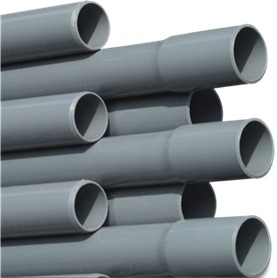
PVC Pipes by Grekkon Limited
PVC Pipe Prices in Kenya
| Size in MM | PN6 | PN8 | PN10 | PN12.5 | PN16 |
| 379 | |||||
| 425 | 532 | ||||
| 32 | 553 | 588 | 694 | 795 | |
| 40 | 698 | 744 | 877 | 1093 | 1220 |
| 50 | 935 | 1,162 | 1,383 | 1705 | 1760 |
| 63 | 1,475 | 1,833 | 2,177 | 2722 | 3359 |
| 75 | 2,024 | 2,529 | 3,111 | 3839 | 4702 |
| 90 | 2,955 | 3,664 | 4,459 | 5527 | 6755 |
| 110 | 3,508 | 4,388 | 5,951 | 6717 | 8260 |
| 140 | 5,782 | 7,060 | 8,795 | 10805 | 13229 |
| 160 | 7,295 | 9,195 | 11,536 | 14189 | 17032 |
| 200 | 11,566 | 14,538 | 17,915 | 22116 | 27086 |
| 225 | 14,610 | 18,210 | 22,521 | 27991 | 34312 |
3. Delivery/ Lay-flat pipes
They are highly flexible irrigation water pipes made from UV treated PVC material.They are supplied as 30M, 50M or 100M long. The diameters are 2″ and 3″, with thicknesses of PN6, PN8 1nd PN10. These pipes are designed for surface use.
In sprinkler irrigation systems, they are connected to a water pump, or a HDPE or PVC pipe main line, then to a water sprinkler. In drip irrigation systems, it will be a main, or sub main line
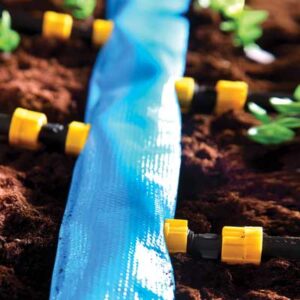
Delivery/ Lay-flat pipe
4. Drip Irrigation Pipes
These are 0.3mm, 0.4mm, and 1mm thick pipes with a 16mm diameter. They are the lateral that deliver water to the base of the crop. The 0.3mm and 0.4mm are for vegetable crops, while the 1mm are for hedges and orchards. They all have pre-perforated emitters spaced at 15cm, 20cm, or 30cm. The choice of emitter spacing depends on the crop type; 15cm for closely spaced crops like onion and garlic, 20cm for moderately spaced crops like tomato, and cabbage. 30cm is for further spaced crops
5. Rain Hose Pipes
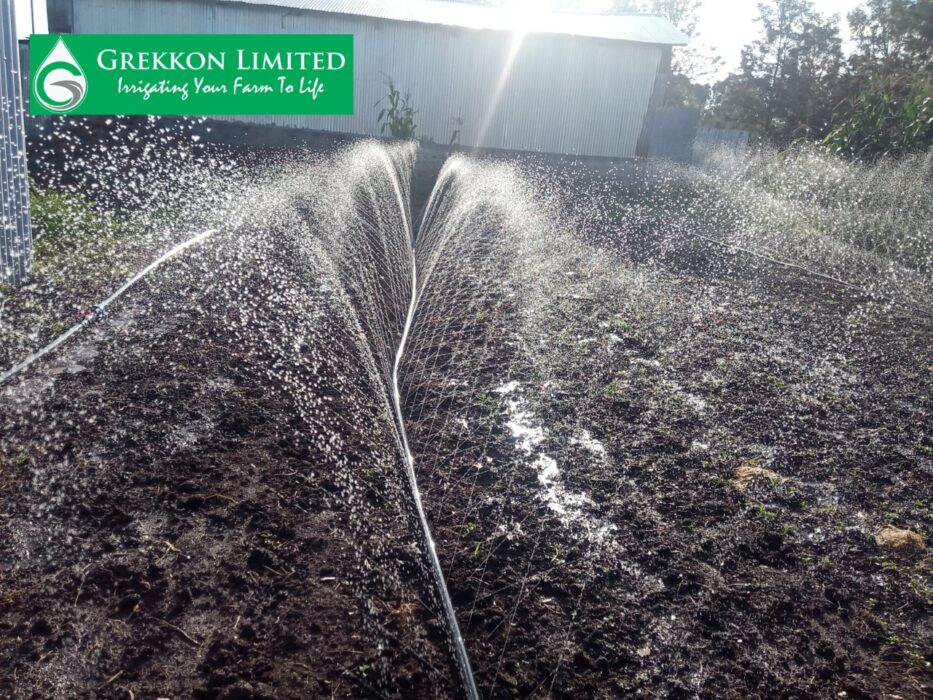
Rain hose irrigation system with nanotechnology punched holes is an affordable irrigation system for overhead irrigation. Rain hose irrigation system uses nano technology to convey water to the plant. It has a series of holes spaced at intervals which sprays water flow by high gravity, or from a water pump is initiated. Our 0.5mm thick, 100M long rain hose pipes are UV treated to last for 10 years in use
Features of a rain hose irrigation system
- It simulates natural rainfall by delivering water to the base of the crop, with the right droplet sizes
- The overhead water is discharged in a 3 dimensional manner; vertically, horizontally, and diagonally
- It is connected directly to a main line
- It is not easily blocked as the water is delivered under high pressure
- The operating pressure is from 15M head / 1.5 bar
Advantages of Grekkon rain hose irrigation pipes
- It is easy to install and maintain, and more economical to install than sprinklers
- It has anti-UV treatment, so it is not easily degraded by the sun
- These spray holes are made with nanotechnology to ensure uniform flow of water
- Irrigate both under gravity flow, and high water pump pressure
- Irrigate an area in just 10 minutes
- Highly portable
- A variety of diameters to select from depending on the farm size
Downsides of a rain hose system
- It is less water efficient compared to drip irrigation
- Water loss due to evaporation
- It cannot be used on crops, for intance, crops that are highly susceptible to fugal infections due to foliage wetness
- It requires high operating pressure
- Rainhose are more prone to clogging than large sprinklers because the have tiny emitters
- Under extremely high pressure, the pipes get damaged
Ideal crops for rain hose irrigation system
Crops that can be irrigated using the grekkon rain hose are:
- Vegetable such as carrots, brassicas, potatoes
- Closely spaced bulbs such as onion and garlic
- Fruit tress; avocado, pixie orange, macadamia, coffee
- Agro forestry
- Lawns, gardens, pasture, and football pitches
They are idea for tree or vegetable nursery irrigation
Types of Irrigation Pipes In Kenya
How to select your irrigation pipe
- Farm ownership method. A leased farm will have the surface HDPE pipes which will be disconnected when the lease period expires. A permanent farm will have sub-surface PVC pipes
- Irrigation method. Drip and rain hose kits will have HDPE and PVC as the main and sub main line often times. Sprinkler systems are best done with delivery pipes due to sprinkler movement in the farm
- Farm size. A larger farm will have larger diameter pipes because more water is needed to irrigate
- Pressure type. Irrigation water flow by gravity is through less thicker pipes such as PN6 or PN8
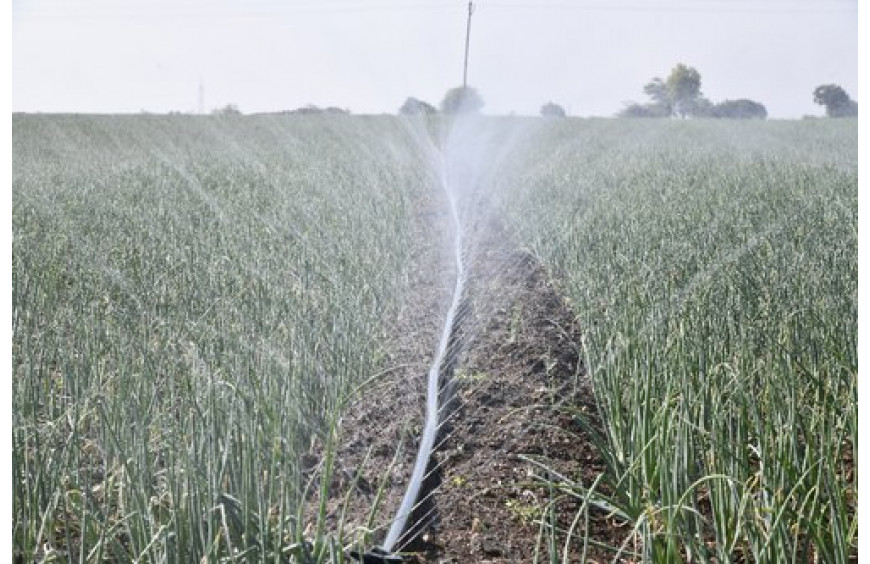
Rain Hose Pipe Price
Grekkon Limited’s rain hose pipe price is by diameter size. Our rain hose for sale in Kenya is attached to a HDPE, PVC, or delivery/ lay-flat irrigation main or sub-main line when in the farm. These rain hose pipes are made from HDPE material with UV treatment for use in tropical climates.
Rain Hose Pipe Price Kenya
| Diameter size | Flow rate per 100M | Diameter of spray at 50M Head | Price in KES |
| 32mm or 1″ | 13 cubic litres per hour | 6M | KES 2,500 |
| 40mm or 1-1/4” | 16 cubic litres per hour | 8M | KES 3,500 |
| 50mm to 1-1/2″ | 22 cubic litres per hour | 9M | KES 4,500 |
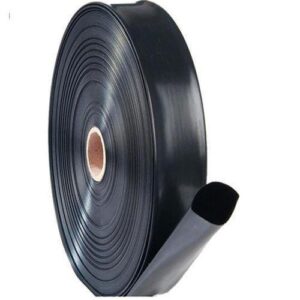
Rain Hose Pipe Price
Rain hose Vs drip irrigation
| Rain hose pipe | Drip irrigation pipe | |||||||
| 1 | Set up cost per acre is from Kes 45,000 | Set up cost per acre is from Kes 90,000 | ||||||
| 2 | Has holes punched with nano technology | Has a drip emitter | ||||||
| 3 | Has many holes per section | Has a single or double drip emitter per section | ||||||
| 4 | Irrigation rate is from 13 cubic litres per hour per 100M length | Irrigation rate is from 8.5 cubic litres per hour per 100M length | ||||||
| 5 | Has thicker (0.5mm) walls so lasts longer | Has thinner walls (0.3mm or 0.4mm) so a shorter lifespan | ||||||
| 6 | Diameter size is from 32mm to 50mm | Diameter size is 16mm | ||||||
| 7 | Maximum pipe length is 100M | Maximum pipe length is 1000M | ||||||
| 8 | Irrigates aerially using sprays | Irrigates to the ground via small drops |
| 9 | Easy to move from section to section in the farm | They are permanently set in one section |
The rain hose pipe price is not a good cost comparison to either drip or sprinkler irrigation. Rather, consider the set up and operational cost per acre under each method of irrigation Rain hose works well with crops that thrive under sprinkler irrigation. Examples are; onion, garlic, cabbage, traditional vegetables, leafy vegetables and others. Crops that are susceptible to fungal infections if the leaves remain wet for long are irrigated with drip. Examples are; green beans, potato, strawberry, tomato, capsicums, peppers and others
Rain Hose Pipe Price
What are the other components of a rain hose irrigation kit?
1. End-caps. They close the end of the pipe to prevent further water flow 2. Starter off-takes. They connect the rain pipe to the PVC or HDPE main line that supplies water to the rain hose from a water pump or highly elevated water tank 3. Pipe connectors. To connect one rain hose pipe to another 4. Mini valves. To control water flow to the rain hose pipe
The diameter of the pipe are; 25mm, 32mm, 40mm and 50mm. A grower chooses the preferred size based on crop water needs and area of irrigation. For instance, a farmer with 1 acre of the crop will comfortably water with the volume delivered through a 32mm rain hose pipe.
Another grower with 5 acres will better irrigate with a 50mm rain hose pipe. An acre of crop uses 1,000 meters of 25mm, 800 meters of 32mm rain hose pipes, 600M of 40mm pipes, and 400M of 50mm pipes
Rain Hose Pipe Price
Irrigation system requirements
- The system requires a pressure head of 30M, and above
- When using a water pump to power the rain hose irrigation kit, the discharge rate should be from 45 cubic litres per hour
- The rate of water discharge is determined by the diameter size, and number of pores on the rain pipe. For instance, a rain pipe with 5 holes per cluster discharges less water than the one with 7 holes in a cluster
- It irrigates in opposite directions at a radius of 3M for the 32mm pipe, 5M for the 40mm pipe, and 7M for the 50mm pipe
- The vertical height of this water jet is 1M
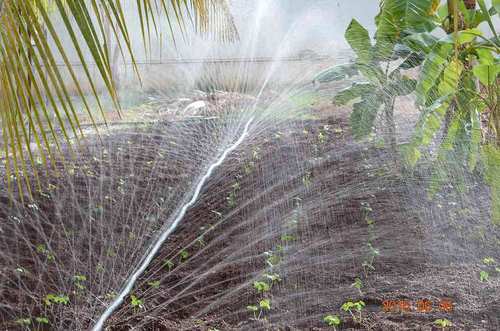
Irrigating a newly transplanted crop with a rain hose pipe
Rain Hose Pipe Price
How to assemble a rain hose irrigation system kit
1. Lay the mainline
This is the pipe delivering irrigation water to the farm from the pump. Your mainline will be larger in size than the rain hose pipe. So if your rain hose pipe is 1” for instance, use a 1.5” or 2″ main or sub mainline
2. Connect to the mainline
Make a 1” insertion on the mainline and attach the off-take connector. The size of the insertion is as per the size of your off-take3. Rain pipe connection
Attach the rain hose pipe to the off-take connector4. Hose to hose connection
Use the connector to attach one rain hose to another5. End cap
Insert the end cap at the end of the hose
Rain Hose Pipe Price
Target areas and crops
- Crop nurseries; vegetables, fruit trees, forestry
- Short vegetable crops (knee-high and below); cabbage, lettuce, broccoli, kales, spinach, collards, broad beans, carrot, strawberry, and others
- Pasture; grass and legumes
When choosing the crop to irrigate using this method, consider its susceptibility to foliage fungal infections predisposed by leaf surface wetness. Tomato, potato, peppers, peas, green beans, and chili easily succumb to foliage fungal infections when overhead or a rain hose system is used for a long time

Pasture irrigation with a rain hose
Rain Hose Irrigation Versus Drip Irrigation
- Rain pipes irrigate in an overhead fashion, drip lines irrigate to the root zone
- Drip tapes are water efficient, rain hose kits require large water volume
- Rain pipes have a higher pressure requirement than drip pipes
- Drip lines have emitters, while rain hose kits have pores done with nano technology
- The discharge rate for drip lines is 1.2 to 4 litres per hour per emitter, while the rain hose pore’s is from 7 litres per hour per emitter
- The cost of a drip kit installation per acre is from Kes 100,000, while the rain hose is from Kes 75,000
- The rain hose pipe’s minimum diameter is 25mm/ 3/4″, while drip tape’s is 8mm
Advantages Of Rain Hose Irrigation
- water saving and cost effective
- It is easy to install, use and maintain
- Ran hose nanotechnology punched holes are less prone to clogging
- It is used in a broad range of crops
- Rain hose pipes are light and easy to move about
- It irrigates uniformly
- It works under both low gravity and high water pump pressure
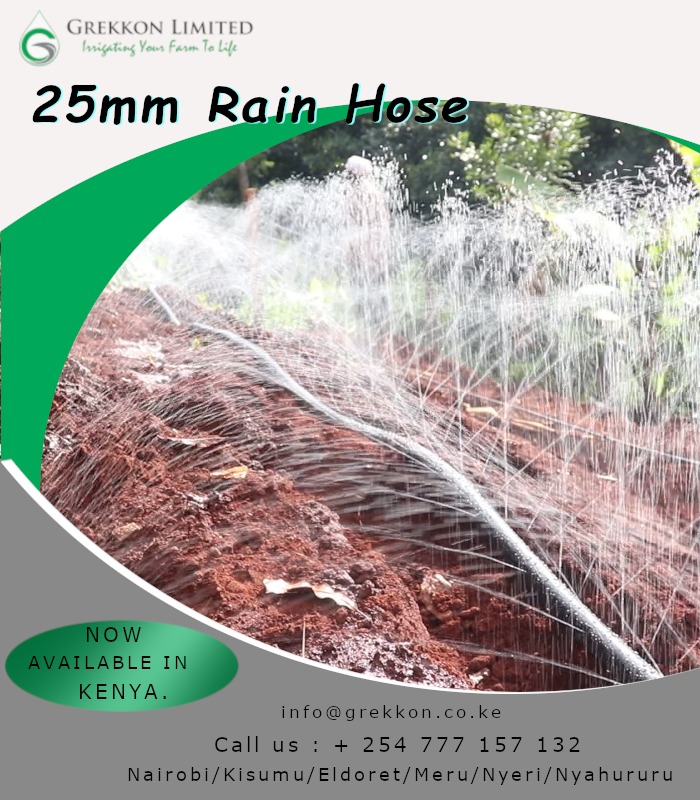
Rain Hose Pipe Price
FAQsa. What is the difference between a rain hose irrigation system and a sprinkler system?
- The technology. The rain pipe irrigation system is designed using nano technology
- The mode of spray. A sprinkler sprays its water in one direction, a rain hose pipe sprays in 3 directions (vertically, horizontally, and diagonally)
- Placement. A sprinkler is placed upright on the surface or sub-surface (for pop up sprinklers). A rain hose is laid on the ground
b. What is the pressure in a rain pipe?
The minimum operating pressure is 30M head / 3 barsc. What is the spacing for rain hose irrigation?
The distance from one rain pipe to another is from 1.5M depending on the operating pressure, and pipe diameterGrekkon limited is the largest supplier and installer of rain hose irrigation systems in Kenya, and in the east and central Africa region. It offres the most affordable rain hose pipe prices
Small Irrigation Equipment Supplier
Grekkon Limited is a small irrigation equipment supplier in east Africa. Domiciled in Kenya, we serve farmers in; Cameroon, DRC, Ethiopia, Kenya, Nigeria, Rwanda, Somalia, South Sudan, Tanzania, Uganda and Zambia.
Our irrigation materials, tools and equipment vary with the system adopted by a grower. Below is our irrigation equipment list
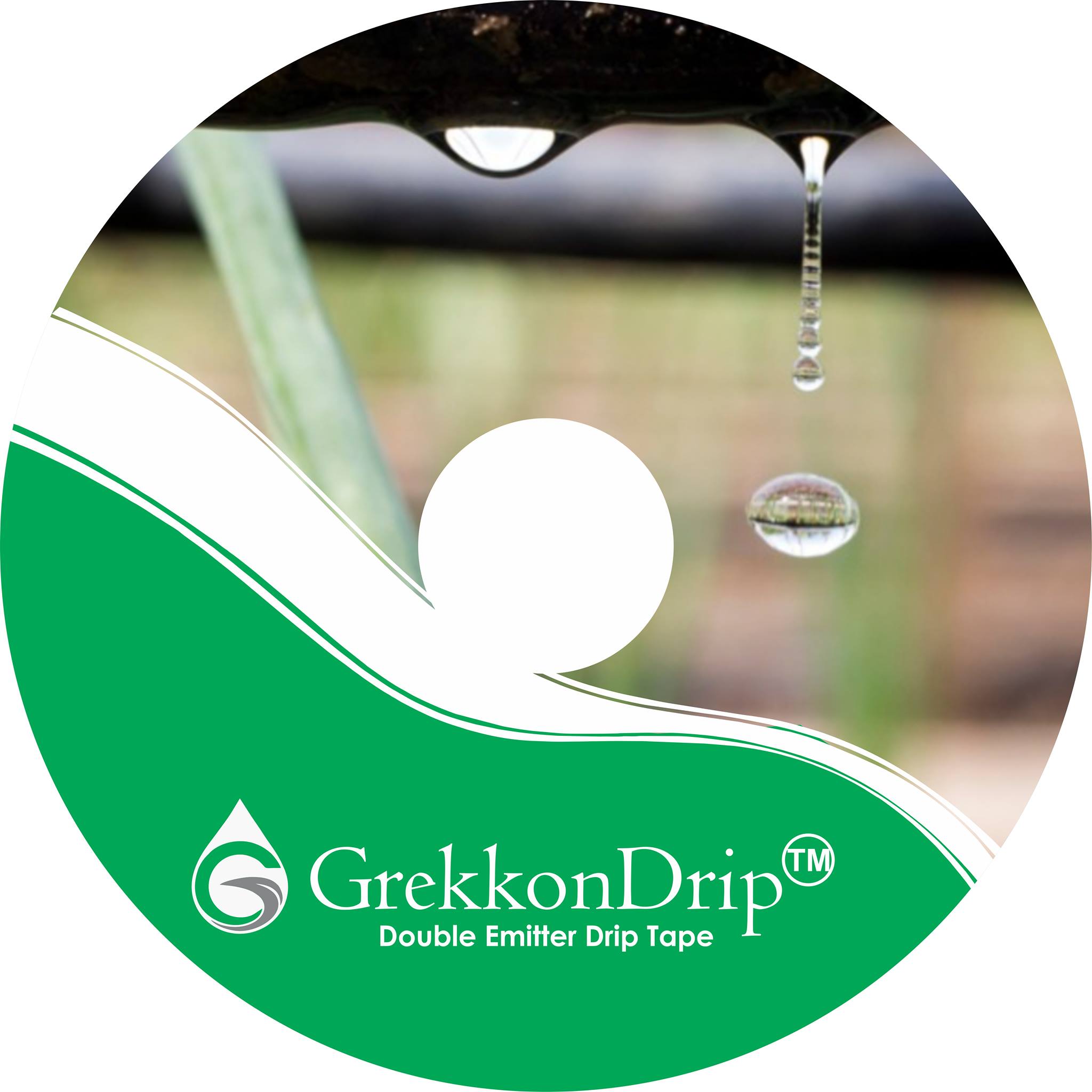
Double emitter drip tapes pioneered in Kenya by Grekkon Limited
Small Irrigation Equipment Supplier
Types of Irrigation Equipment
- Drip kits. For both vegetable and fruit tree/ forestry irrigation. This includes; drip tape, 16mm HDPE pipe, starter connectors, off-takes, drip to drip connectors, button or online drippers, and end caps
- Rain hose kits. It has; rain hose pipe, off-takes, connectors, and an end cap. Rain hose kits are best utilised where drip irrigation systems cannot be installed such as is pasture, or crop nurseries
- Sprinkler systems. There are various types;
3.1. Pop up sprinklers. These are sub-surface sprinklers for lawns, golf course, football pitches, and gardens
3.2. Rain gun sprinklers. These are metallic high pressure, high volume sprinklers for use in all crops. They are well utilised in larger acreage because they have a wide area of spray
3.3. Impact sprinklers. They are plastic and range from 1/2″ to 1″. Mostly used to irrigate small vegetable farmes, or pasture
3.4. Meganet sprinklers. These are plastic sprinklers that range from 1/2” to 1”. They are a suitable alternative to impact sprinklers
3.5. Butterfly type sprinklers. They are for lawns and small gardens like the kitchen garden
3.5. Micro sprinklers. They irrigate individual fruit tree plants, just like button drippers. However they cover a wider area, and provide better humidity around the crop’s root zone
In this video below, a smallholder farmer who was an early adapter of Grekkon’s rain hose kits. She speaks about her growing experience
4. Misters and foggers. Used in greenhouses for seedlings watering, and humidity control

Solar water pumps by Grekkon Limited
5. Water pumps;
As an irrigation equipment supplier, every irrigation system is backed by the following types of water pumps to draw water from a source, to supply the irrigation system
i. Solar water pumps. These are either surface or submersible types. Submersible water pumps work under water, while surface water pumps are ground based
ii. Electric water pumps. Like solar water pumps, they’re surface and submersible options
iii. Diesel generator water pumps. They run on diesel powered engines. They are portable or fixed types. The latter are larger in size
iv. Petrol water pumps. They run on petrol powered engines, and are smaller than diesel water pumps
Small Irrigation Equipment Supplier
Water pump accessories
Accessories that accompany motor powered pumps are; foot valves, clips, suction pipes, adaptors, splicing kits, control boxes, invertors (for DC to AC converstion) cables, cable ties, solar panels (for solar pumps), and a solar panel support structure
Accessories that accompany motor powered pumps are; foot valves, clips, suction pipes, and adaptors
Every irrigation system has a main, and/ or sub-main pipes. Our irrigation pipes are HDPE and PVC. We advice on the right pipe thickness, size and type based on
- Land size; determines pipe size. Large pipes for large acreage. Our pipe sizes range from 16mm to 180mm in diameter
- Irrigation system adopted; any of the 1 to 3 above
- Land ownership system; leased or owned? HDPE for the former, PVC for the latter
These pipes have specific fittings which are; elbows, tees, valve sockets, ball valves, couplings, adaptors,sockets,saddle clamps, and end caps by type and size

Drip irrigation system under installation by Grekkon Limited using PVC pipes as main and sub-main lines
Small Irrigation Equipment Supplier
Installation Service
Our irrigation service team conducts systems installations service in east Africa. We offer advisory services to manage the system well for many years

A client’s irrigation system installation by a company technician
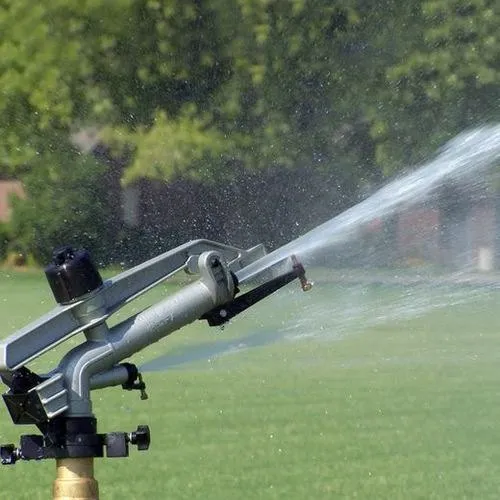
Long Range Sprinkler
Our long range sprinkler models irrigate large acreage of horticulture, fruit, corn, wheat, barley, canola, and potato crops. Every long range sprinkler in Kenya by Grekkon Limited is from 1-1/2” to 2-1/2” inlet diameter size. These sprinklers provide fine rain drop sized watering in the field when operating at optimal capacity
Long range sprinkler specifications
- Material. Aluminum, brass, and steel
- Nozzle sizes. 12mm, 16mm, 18mm, and 20mm
- The diameter of spray. 35M to 40M for the 1-1/2” and 45M to 60M for the 2”
- Discharge volume. 15 cubic to 30 cubic per hour for the 1-1/2” and 20 cubic to 45 cubic per hour for the 2″
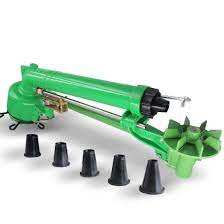
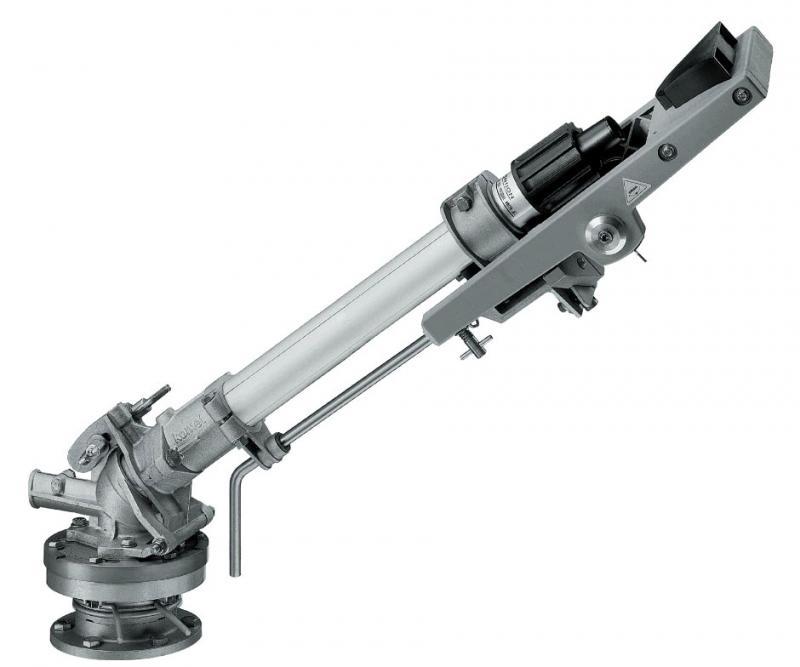
Note that the diameter of spray and discharge volume is a factor of the nozzle size and diesel or electric pump capacity (engine/ motor size, pressure rating, and discharge rate)
How much is a long range sprinkler in Kenya?
- 1-1/2” is Kes 55,000
- 2” is Kes 65,000
This cost is inclusive of the steel tripod stand
How to work with long range sprinkler requirements
i. Water availability. It requires 30 cubic per hour as a minimum. If irrigation takes 5 hours per day, then 150 cubic must be available
ii. Pressure. Check your ground elevation, determine your pressure loss in the system and your pipe size. Work backward to determine the water pump type that matches your sprinkler choice. The frictional losses along the pipeline will be taken into consideration too
iii. Crop water requirement. This determines the time spent in irrigation
iv. Land size. This will determine the number of units to run per session

A long range 2″ rain gun sprinkler on display at Grekkon Limited’s ware house in Athi River
Long range sprinkler
FAQs
1. How much does a sprinkler system cost in Kenya?
The cost of a sprinkler system in Kenya is from Kes 55,000 per acre depending on the sprinkler type and number of sprinklers installed
2. What is the distance of a rain gun?
This is from 17M to 50M diameter of spray
3. How much HP motor is required for a rain gun?
A ran gun sprinkler will work with a fossil fuel powered water pump with an engine power from 7.5Hp
4. What pressure is needed for a rain gun?
From 3 bars or 30M lift
5. How to select a long range sprinkler?
Consider the following
- water volume available
- the water pump specifications
- the lift or ground elevation
- the acreage under irrigation
- your budget
6. What are the benefits of a long range sprinkler system?
- it irrigates over a short period of time saving energy
- it is movable
- there are different sizes to choose from
- it covers both small and large acreage
- it is easy to install
- a large volume of water is provided
- it raises the humidity level around the crop
7. What are the disadvantages of a long range sprinkler?
- it consumes copius amounts of water
- it requires a large water pump for energy
- if left operational for a longer than recommeneded period, it causes soil erosion
- it will not work with gravity flow as the pressure is too low
- it is unsuitable for certain crops because they cause flowe rabortion or make them more susceptible to fungal infections when the foliage is left moist
8. How efficient is a rain gun?
It uses half the water volume that flood irrigation would use. However, it uses more than 3 times what would be achieved under drip irrigation
9. What is the diameter of a rain gun sprinkler?
The diameter of a rain gun sprinkler is from 1″ through 2-1/2″
10. How long does a sprinkler system last?
From 20 years under proper care for the metallic types, and just under 5 years for th plastic analogues
11. How effective is rain gun irrigation?
It is carried out for many crops so long as there is sufficient water volume at the source. It is particularly useful for crops that have large spaces in between
12. What is the difference between rain gun and drip irrigation?
- water application. Rain guns apply from the top (overhead), while drip pipes apply from below
- water efficiency. Drip irrigtaion is more water efficient
- cost. drip irrigation systems are more expensive to install
- crop type. drip irrigation will be used for more crop types than rain gun sprinklers
- rain gun sprinklers unlike drip lines will be installed in uneven terrain
- rain gun sprinklers are preferred most under large acreage
13. How many minutes should I run my rain gun?
Depending on the rain gun size, this is from 15 minutes for the large ones, to 35 minutes for the smaller types. Irrigation is done twice a week
14. How do you maintain your sprinkler system?
- ensure that there are no blockages
- clean any debris stuck
- change or repair any loose springs
- limit the number of operators to one 2 persons only

A 2-1/2″ long range rain gun sprinkler at work
Long range sprinkler
Your long range rain gun sprinkler will have a tripod steel support stand. The water delivery pipe is attached to the hollow bottom of the stand. The diameter size of this hollow bottom is the sprinkler’s size
The water drops are fine to use on flowering crops without causing flower abortion. On solanaceous crops such as; tomatoes, potatoes, peppers, irrigate in the morning hours and not in the evening. This allows the moisture to dry off from the leaves, which minimises blight or mildew infection
Before installation, our technical team makes a site visit to make the system layout plan. This is important to ensure that every inch of the farm is covered during irrigation and that there are no dry shadows
These giant sprinklers irrigate over a short period of time, in a large area
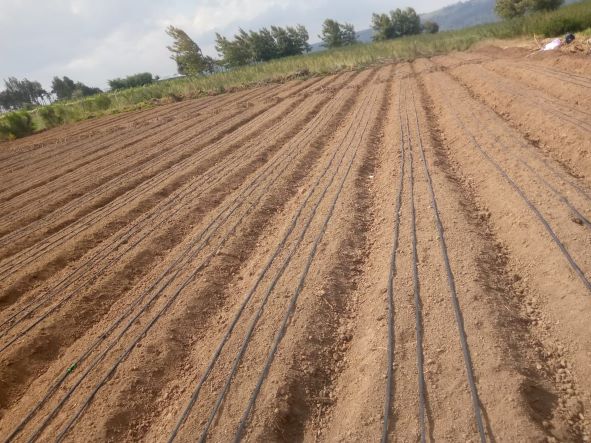
Cost Of Drip Irrigation Per Acre
The cost of drip irrigation per acre in Kenya varies from crop to crop. Grekkon Limited is the top most of all drip irrigation kits suppliers in Kenya. Our drip irrigation system price in Kenya depends on the crop type
For tree crops and hedges, button drippers are installed. In vegetable crops, pre-perforated drip pipes are laid. The emitter spacing on the pre-perforated drip lines is either; 15cm, 20cm, or 30cm. A grower selects according to the vegetable crop type spacing.
We provide our growers a choice of single or double emitter drip irrigation tapes. Double emitter drip lines are helpful in high saline irrigation water locations where salt precipitates form and clog drip emitters. When one emitter is clogged, then the other one continues to irrigate at the same rate. Drip irrigation pipes for sale in Kenya by Grekkon Limited are PVC, and HDPE types
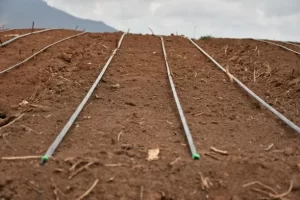
A 3-row drip per bed installation for a vegetable by Grekkon Limited in Ol-Donyo Sabuk area, Machakos county
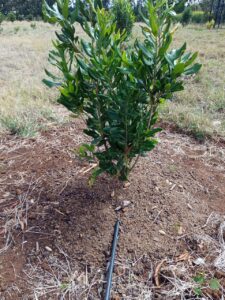
A button dripper irrigation system on macadamia in Item area, Elgeyo Marakwet county by Grekkon Limited
Cost of Drip Irrigation Per Acre
Determining Factors
- Crop type.It determines the crop spacing. Is it a fruit or vegetable garden? Fruit trees and fruit vines or runners such as melons 🍉 take less drip tape per acre. So they have the least cost. Vegetable crops take more drip lines, and are thus more expensive
- Pipe type. It is a PVC or HDPE mainline, and sub-mainline? The former is more expensive to work with
- Water pressure available. The higher the pressure, the less the number of irrigation blocks. Less irrigation blocks per acre means less fittings and accessories, so it’s less expensive. With low pressure, more irrigation blocks are created, at a higher unit cost
I. An Eighth To One Acre Drip Irrigation Kit Prices
| Crop Type | Drip Lines Per Bed | Acreage | Cost in Kes |
| Watermelon | 1 | 1/8 | 15,000 |
| 1/4 | 25,000 | ||
| 1/2 | 45,000 | ||
| 1 | 85,000 | ||
| Tomato, cabbage, chilies, capsicum, green beans, peas | 2 | 1/8 | 25,000 |
| 1/4 | 40,000 | ||
| 1/2 | 75,000 | ||
| 1 | 140,000 | ||
| Onion, garlic, herbs, spices, strawberry | 1/8 | 27,500 | |
| 3 | 1/4 | 45,000 | |
| 1/2 | 85,000 | ||
| 1 | 160,000 |
II. Fruit Tree Button Drip Kit Irrigation Prices
| Crop Type | Acreage | Cost in Kes |
| Tree Tomato/ Pawpaw/ Passion/ Coffee | 1/8 | 15,000 |
| 1/4 | 25,000 | |
| 1/2 | 45,000 | |
| 1 | 85,000 | |
| Avocado | 1/8 | 15,000 |
| 1/4 | 25,000 | |
| 1/2 | 40,000 | |
| 1 | 70,000 |
FAQS
a. How much does it cost to install a drip irrigation system in Kenya?
The tabulated cost of drip irrigation per acre in Kenya includes the cost of installation by our technicians. We conduct our installations in all of east Africa, for every grower. After installation, our agronomy team provides 4 months of free agronomy training for new farmers.
b. How much does drip irrigation cost per hectare?
The cost of drip irrigation per hectare is 2.5 times the cost provided per acre
c. How many drip lines per acre?
This is determined by the crop type. 3,000M for 1 drip row per bed, 6,000M for 2 drip rows per bed, and 8,000M for 3 drip rows per bed
4. What is the maximum length of a drip irrigation line?
Your 16mm drip irrigation line will run for 25 to 27M under gravity flow, where the head is below 10M. From 10M head, this will go up to 50M
5. How far apart are drip irrigation holes?
Our emitter spacing is; 15cm, 20cm, and 30cm
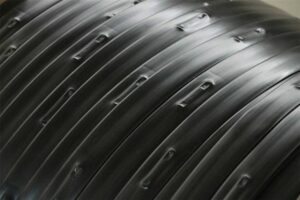
15cm drip emitter spacing on a 1,00M single emitter drip roll
6. How do I calculate drip irrigation?
- Determine the emitter spacing, for example 15cm
- Divide the drip length by this spacing to determine the number of emitters per roll. In our case, 1,000M divided by 0.15M= 6,667 emitters
- Multiply the emitters by the number of rolls per acre, for example 6 rolls, so 40,000 emitters per acre
- Multiply the emitter flow rate by the total number of emitters to get the amount of water discharged per hour. For example 1.5 litres per hour x 40,000= 60,000 litres per hour
7. Which pipe is best for drip irrigation?
HDPE pipes are the best as main and sub main lines because they have UV treatment. This means that they will be used either as surface or sub-surface pipes
8. Can you run a drip line uphill?
Yes. But the head of the flow must be higher than the vertical height of the slope
9. What pipe size should I use for drip irrigation?
The size of the main or sub main pipe installed is determined by the area under irrigation. The larger it is, the larger the pipes used
10. How do I know how long to run drip irrigation?
This is determined by the existing level of soil moisture. Run it for 20 minutes to 1 hour according to the amount of water needed
11. How do I increase the pressure in my drip irrigation system?
They are several ways to raise the irrigation water pressure in your drip irrigation system
i. Divide the farm into blocks, each of which is irrigated separately. This way, irrigation water is channeled to particular block under high pressure
ii. If it is by gravity flow, then by raising the storage elevation. This will work where raised water tanks are the source of irrigation water
iii. By introducing an external source of pressure, such a s water pump to boost the flow of irrigation water in the system

